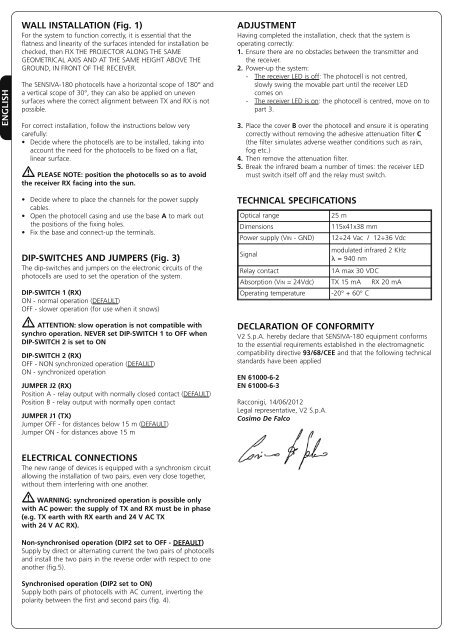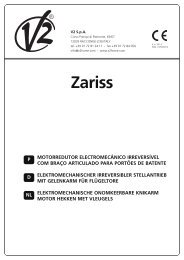SENSIVA-180 - V2
SENSIVA-180 - V2
SENSIVA-180 - V2
You also want an ePaper? Increase the reach of your titles
YUMPU automatically turns print PDFs into web optimized ePapers that Google loves.
ENGLISH<br />
WALL INSTALLATION (Fig. 1)<br />
For the system to function correctly, it is essential that the<br />
flatness and linearity of the surfaces intended for installation be<br />
checked, then FIX THE PROJECTOR ALONG THE SAME<br />
GEOMETRICAL AXIS AND AT THE SAME HEIGHT ABOVE THE<br />
GROUND, IN FRONT OF THE RECEIVER.<br />
The <strong>SENSIVA</strong>-<strong>180</strong> photocells have a horizontal scope of <strong>180</strong>° and<br />
a vertical scope of 30°, they can also be applied on uneven<br />
surfaces where the correct alignment between TX and RX is not<br />
possible.<br />
For correct installation, follow the instructions below very<br />
carefully:<br />
• Decide where the photocells are to be installed, taking into<br />
account the need for the photocells to be fixed on a flat,<br />
linear surface.<br />
m PLEASE NOTE: position the photocells so as to avoid<br />
the receiver RX facing into the sun.<br />
ADJUSTMENT<br />
Having completed the installation, check that the system is<br />
operating correctly:<br />
1. Ensure there are no obstacles between the transmitter and<br />
the receiver.<br />
2. Power-up the system:<br />
- The receiver LED is off: The photocell is not centred,<br />
slowly swing the movable part until the receiver LED<br />
comes on<br />
- The receiver LED is on: the photocell is centred, move on to<br />
part 3.<br />
3. Place the cover B over the photocell and ensure it is operating<br />
correctly without removing the adhesive attenuation filter C<br />
(the filter simulates adverse weather conditions such as rain,<br />
fog etc.)<br />
4. Then remove the attenuation filter.<br />
5. Break the infrared beam a number of times: the receiver LED<br />
must switch itself off and the relay must switch.<br />
• Decide where to place the channels for the power supply<br />
cables.<br />
• Open the photocell casing and use the base A to mark out<br />
the positions of the fixing holes.<br />
• Fix the base and connect-up the terminals.<br />
DIP-SWITCHES AND JUMPERS (Fig. 3)<br />
The dip-switches and jumpers on the electronic circuits of the<br />
photocells are used to set the operation of the system.<br />
DIP-SWITCH 1 (RX)<br />
ON - normal operation (DEFAULT)<br />
OFF - slower operation (for use when it snows)<br />
m ATTENTION: slow operation is not compatible with<br />
synchro operation. NEVER set DIP-SWITCH 1 to OFF when<br />
DIP-SWITCH 2 is set to ON<br />
DIP-SWITCH 2 (RX)<br />
OFF - NON synchronized operation (DEFAULT)<br />
ON - synchronized operation<br />
JUMPER J2 (RX)<br />
Position A - relay output with normally closed contact (DEFAULT)<br />
Position B - relay output with normally open contact<br />
JUMPER J1 (TX)<br />
Jumper OFF - for distances below 15 m (DEFAULT)<br />
Jumper ON - for distances above 15 m<br />
TECHNICAL SPECIFICATIONS<br />
Optical range<br />
Dimensions<br />
Power supply (VIN - GND)<br />
Signal<br />
DECLARATION OF CONFORMITY<br />
<strong>V2</strong> S.p.A. hereby declare that <strong>SENSIVA</strong>-<strong>180</strong> equipment conforms<br />
to the essential requirements established in the electromagnetic<br />
compatibility directive 93/68/CEE and that the following technical<br />
standards have been applied<br />
EN 61000-6-2<br />
EN 61000-6-3<br />
Racconigi, 14/06/2012<br />
Legal representative, <strong>V2</strong> S.p.A.<br />
Cosimo De Falco<br />
25 m<br />
115x41x38 mm<br />
12÷24 Vac / 12÷36 Vdc<br />
modulated infrared 2 KHz<br />
l = 940 nm<br />
Relay contact<br />
1A max 30 VDC<br />
Absorption (VIN = 24Vdc) TX 15 mA RX 20 mA<br />
Operating temperature<br />
-20° + 60° C<br />
ELECTRICAL CONNECTIONS<br />
The new range of devices is equipped with a synchronism circuit<br />
allowing the installation of two pairs, even very close together,<br />
without them interfering with one another.<br />
m WARNING: synchronized operation is possible only<br />
with AC power: the supply of TX and RX must be in phase<br />
(e.g. TX earth with RX earth and 24 V AC TX<br />
with 24 V AC RX).<br />
Non-synchronised operation (DIP2 set to OFF - DEFAULT)<br />
Supply by direct or alternating current the two pairs of photocells<br />
and install the two pairs in the reverse order with respect to one<br />
another (fig.5).<br />
Synchronised operation (DIP2 set to ON)<br />
Supply both pairs of photocells with AC current, inverting the<br />
polarity between the first and second pairs (fig. 4).



